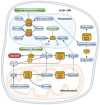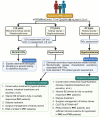Navigating the Evolving Landscape of Primary Hyperoxaluria: Traditional Management Defied by the Rise of Novel Molecular Drugs
- PMID: 38785918
- PMCID: PMC11117870
- DOI: 10.3390/biom14050511
Navigating the Evolving Landscape of Primary Hyperoxaluria: Traditional Management Defied by the Rise of Novel Molecular Drugs
Abstract
Primary hyperoxalurias (PHs) are inherited metabolic disorders marked by enzymatic cascade disruption, leading to excessive oxalate production that is subsequently excreted in the urine. Calcium oxalate deposition in the renal tubules and interstitium triggers renal injury, precipitating systemic oxalate build-up and subsequent secondary organ impairment. Recent explorations of novel therapeutic strategies have challenged and necessitated the reassessment of established management frameworks. The execution of diverse clinical trials across various medication classes has provided new insights and knowledge. With the evolution of PH treatments reaching a new milestone, prompt and accurate diagnosis is increasingly critical. Developing early, effective management and treatment plans is essential to improve the long-term quality of life for PH patients.
Keywords: AGXT; GRHPR; HOGA1; RNA interference; genetics; oxalate; primary hyperoxaluria.
Conflict of interest statement
The authors declare no conflicts of interest.
Figures


Similar articles
-
Targeting kidney inflammation as a new therapy for primary hyperoxaluria?Nephrol Dial Transplant. 2019 Jun 1;34(6):908-914. doi: 10.1093/ndt/gfy239. Nephrol Dial Transplant. 2019. PMID: 30169827 Review.
-
Pathophysiology and Management of Hyperoxaluria and Oxalate Nephropathy: A Review.Am J Kidney Dis. 2022 May;79(5):717-727. doi: 10.1053/j.ajkd.2021.07.018. Epub 2021 Sep 9. Am J Kidney Dis. 2022. PMID: 34508834 Review.
-
Generation and characterization of a novel rat model of primary hyperoxaluria type 1 with a nonsense mutation in alanine-glyoxylate aminotransferase gene.Am J Physiol Renal Physiol. 2021 Mar 1;320(3):F475-F484. doi: 10.1152/ajprenal.00514.2020. Epub 2021 Jan 25. Am J Physiol Renal Physiol. 2021. PMID: 33491567
-
Molecular basis of primary hyperoxaluria: clues to innovative treatments.Urolithiasis. 2019 Feb;47(1):67-78. doi: 10.1007/s00240-018-1089-z. Epub 2018 Nov 14. Urolithiasis. 2019. PMID: 30430197 Review.
-
Specific Inhibition of Hepatic Lactate Dehydrogenase Reduces Oxalate Production in Mouse Models of Primary Hyperoxaluria.Mol Ther. 2018 Aug 1;26(8):1983-1995. doi: 10.1016/j.ymthe.2018.05.016. Epub 2018 Jun 15. Mol Ther. 2018. PMID: 29914758 Free PMC article.
Cited by
-
Synthesis and hLDHA Inhibitory Activity of New Stiripentol-Related Compounds of Potential Use in Primary Hyperoxaluria.Int J Mol Sci. 2024 Dec 10;25(24):13266. doi: 10.3390/ijms252413266. Int J Mol Sci. 2024. PMID: 39769031 Free PMC article.
References
-
- Lepoutre C. Calculs Multiples Chez Un Enfant: Infiltration Du Parenchyme Rénal Par Des Dépots Cristallins. J. Urol. 1925;20:424.
-
- Hautmann R., Osswald H. Pharmacokinetic Studies of Oxalate in Man. Investig. Urol. 1979;16:395–398. - PubMed
Publication types
MeSH terms
Substances
Grants and funding
LinkOut - more resources
Full Text Sources

